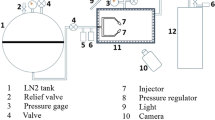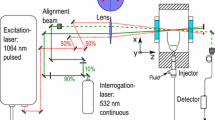Abstract
The electrical and atomization performance of a plane–plane charge injection atomizer using a dielectric liquid, and operating at pump pressures ranging from 15 to 35 bar corresponding to injection velocities of up to 50 m/s, is explored via low current electrical measurements, spray imaging and phase Doppler anemometry. The work is aimed at understanding the contribution of electrostatic charging relevant to typical higher pressure fuel injection systems such as those employed in the aeronautical, automotive and marine sectors. Results show that mean-specific charge increases with injection velocity significantly. The effect of electrostatic charge is advantageous at the 15–35 bar range, and an arithmetic mean diameter D 10 as low as 0.2d is achievable in the spray core and lower still in the periphery where d is the orifice diameter. Using the data available from this higher pressure system and from previous high Reynolds number systems (Shrimpton and Yule Exp Fluids 26:460–469, 1999), the promotion of primary atomization has been analysed by examining the effect that charge has on liquid jet surface and liquid jet bulk instability. The results suggest that for the low charge density Q v ~ 2 C/m3 cases under consideration here, a significant increase in primary atomization is observed due to a combination of electrical and aerodynamic forces acting on the jet surface, attributed to the significantly higher jet Weber number (We j) when compared to low injection pressure cases. Analysis of Sauter mean diameter results shows that for jets with elevated specific charge density of the order Q v ~ 6 C/m3, the jet creates droplets that a conventional turbulent jet would, but with a significantly lower power requirement. This suggests that ‘turbulent’ primary atomization, the turbulence being induced by electrical forces, may be achieved under injection pressures that would produce laminar jets.









Similar content being viewed by others
Abbreviations
- a :
-
Orifice plate thickness (m)
- C :
-
Empirical model coefficient
- d :
-
Orifice diameter (m or μm)
- D :
-
Droplet diameter (m or μm)
- E :
-
Applied electric field (V/m)
- F :
-
Volume flow rate (m3/s)
- I L :
-
Leakage current (μA)
- I S :
-
Spray current (μA)
- L :
-
Inter-electrode gap (m or μm)
- L break :
-
Jet break-up length (m or cm)
- P :
-
Applied pressure (Bar)
- Q v :
-
Spray-specific charge (C/m3)
- u inj :
-
Liquid injection velocity (m/s)
- V :
-
Applied voltage (volt or kilovolt)
- z :
-
Downstream position (m or cm)
- δ0 :
-
Perturbation scale (m)
- ε:
-
Electrical permittivity (Farad/m)
- κ:
-
Ionic mobility (m2/Vs)
- λ:
-
Wavelength (nm)
- Λ:
-
Integral length scale (m)
- μ:
-
Dynamic viscosity (Pas)
- ρ:
-
Density (kg/m3)
- σ:
-
Surface tension (N/m)
- τ:
-
Timescale (s or ms)
References
Alj A, Denat A, Gosse JP, Gosse B (1985) Creation of charge carriers in nonpolar liquids. IEEE Trans Electr Insul 20:221–231
Allen J, Ravenhill P, Shrimpton JS (2005) Spray characteristics of a novel multi orifice electrostatic atomizer. Proceedings of the 20th ILASS Europe meeting, pp 373–377
Atten P (1996) Electro hydrodynamic instability and motion induced by injected space charge in insulating liquids. IEEE Trans Dielectr Electr Insul 3:1–17
Bankston CP, Back LH, Kwack EY, Kelly AJ (1988) Experimental investigation of electrostatic dispersion and combustion of diesel fuel jets. J Eng Gas Turbines Power 110:361–368
Castellanos A (1991) Coulomb-driven convection in electro hydrodynamics. IEEE Trans Electr Insul 26:1201–1215
Castellanos A (1998) Electrohydrodynamics, 1st edn. Springer, New York
Faeth GM, Hsiang LP, Wu PK (1995) Structure and break-up properties of sprays. Int J Multiphase Flow 21:99–127
Gomez A, Tang K (1994) Charge and fission of droplets in electrostatic sprays. Phys Fluids 6:404–414
Grant RP, Middleman S (1966) Newtonian jet stability. Am Inst Chem Eng J 12:669–678
Jaworek A, Krupa A (1999) Jet and drops formation in electro hydrodynamic spraying of liquids. A systematic approach. Exp Fluids 27:43–52
Kelly AJ (1984) The electrostatic atomization of hydrocarbons. J Inst Energy 57:312–320
Kim K, Turnbull RJ (1976) Generation of charged drops of insulating liquids by electrostatic spraying. J Appl Phys 47:1964–1969
Kourmatzis A, Shrimpton JS (2011) Electrical and transient atomization characteristics of a pulsed charge injection atomizer. J Electrostat 69:157–167
Kourmatzis A, Shrimpton JS (2012) Turbulent three dimensional dielectric electrohydrodynamic (EHD) convection between two plates. J Fluid Mech (in press)
Kourmatzis A, Allen J, Shrimpton JS (2010) Electrical and spray characteristics of a multiorifice charge-injection atomizer for electrically insulating liquids. Atomization Spray 20:269–280
Kwack EY, Back LH, Bankston CP (1989) Electrostatic dispersion of diesel fuel jets at high back pressure. ASME Trans 111:578–586
Kyritsis DC, Coriton B, Faure F, Roychoudhury S, Gomez A (2004) Optimization of a catalytic combustor using electrosprayed liquid hydrocarbons for mesoscale power generation. Combust Flame 139:539–563
Lefebvre AH (1989) Atomization and sprays. Taylor and Francis, New York
Li L, Yu S, Hu Z (2006) Theoretical and experimental studies of electrospray for IC engine. Society for Automotive Engineers pp 139–147
Malkawi G (2010) Point-to-plane and plane-to-plane electrostatic charge atomization for insulating liquids, PhD Thesis, University of Illinois at Chicago, Chicago
Marginean I, Znamensiy V, Vertes A (2006) Charge reduction in electrosprays: slender nanojets as intermediates. J Phys Chem B 110:6397–6404
Melcher RJ (1981) Continuum electromechanics. MIT press, Cambridge
Ohnesorge W (1936) Formation of drops by nozzles and the break-up of liquid jets. Zeitschrift fur Angewandte Mathematik und Mechanik 16:355–358
Rayleigh L (1878) On the instability of jets. Proc Lond Math Soc 10:4–13
Rigit ARH, Shrimpton JS (2006a) Electrical performance of charge injection electrostatic atomizers. Atomization Spray 16:401–419
Rigit ARH, Shrimpton JS (2006b) Spray characteristics of charge injection electrostatic atomizers with small orifice diameters. Atomization Spray 16:421–442
Schneider JM, Watson PK (1970) Electrohydrodynamic instability of space-charge-limited currents in dielectric liquids, i. theoretical study. Phys Fluids 18:1948–1954
Shrimpton JS (1995) Electrostatic atomization and combustion of hydrocarbon oils, PhD Thesis, University of Manchester, Manchester, UK
Shrimpton JS, Laoonual Y (2006) Dynamics of electrically charged transient evaporating sprays. Int J Numer Methods Eng 67:1063–1081
Shrimpton JS, Yule AJ (1995) Atomization, combustion, and control of charged hydrocarbon sprays. Atomization Spray 11:1–32
Shrimpton JS, Yule AJ (1999) Characterization of charged hydrocarbon sprays for application in combustion systems. Exp Fluids 26:460–469
Shrimpton JS, Yule AJ (2003) Electrohydrodynamics of charge injection atomization: regimes and fundamental limits. Atomization Spray 12:173–190
Shrimpton JS, Yule AJ (2004) Design issues concerning charge injection atomizers. Atomization Spray 14:127–142
Weber C (1931) Disintegration of liquid jets. Zeitschrift fur Angewandte Mathematik und Mechanik 11:136–159
Wu PK, Miranda RF, Faeth GM (1995) Effects of initial flow conditions on primary break-up of nonturbulent and turbulent round liquid jets. Atomization Spray 5:175–196
Yoon SS, Heister SD (2003) Categorizing linear theories for atomizing round jets. Atomization Spray 13:499–516
Yoon SS, Heister SD (2004) A nonlinear atomization model based on a boundary layer instability mechanism. Phys Fluids 16:47–61
Acknowledgments
The authors thank Spraying Systems Co. for lending us the Zenith high-pressure pump for the electrical measurements. Thanks also go to the world universities network (WUN) for funding the trip to the United States which allowed for this work to be undertaken.
Author information
Authors and Affiliations
Corresponding author
Rights and permissions
About this article
Cite this article
Kourmatzis, A., Ergene, E.L., Shrimpton, J.S. et al. Combined aerodynamic and electrostatic atomization of dielectric liquid jets. Exp Fluids 53, 221–235 (2012). https://doi.org/10.1007/s00348-012-1284-6
Received:
Revised:
Accepted:
Published:
Issue Date:
DOI: https://doi.org/10.1007/s00348-012-1284-6




